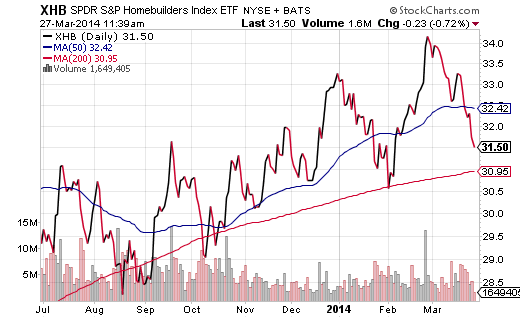Don’t blame weakness in home sales on weather conditions. The National Association of Realtor’s pending home sales index has fallen for eight consecutive months. In fact, you can trace the trouble directly back to when 30-year fixed mortgages pole vaulted from 3.5% to 4.5% in the summer of 2013.
The rate-sensitive home-building segment has been able to cling to a technical uptrend in spite of increasing uncertainty surrounding home affordability. Yet, the SPDR S&P Homebuilders ETF (XHB) is down roughly 5% in 2014 and straining to keep pace with the broader market.
The financial media tend to focus on signs of economic strength. For example, commentators and analysts celebrated U.S. economic output hitting 2.6% for the final quarter of 2013. Lost in translation is the reality that GDP for all of 2013 came in at a below-trend 1.9%, down substantially from 2.8% in 2012. Equally worrisome, the U.S. hasn’t come close to sniffing the average output of 4% growth in the 1990s.
Until recently, declines in home sales have not mattered to bullish advocates for stocks. Nor have investors been bothered by declines in the percentage of working-aged individuals in the workforce and declines in purchasing power due to stagnant wages. That said, the first quarter underperformance of consumer-oriented ETFs like SPDR Select Sector Consumer Discretionary (ARCA:XLY) may be an indication of genuine concern. The remarkable drop-off is demonstrated in the XLY:S&P 500 price ratio below.

The majority of economists are predicting that the economy will accelerate. Such acceleration typically coincides with rising interest rates and falling bond prices. In the first three months of the year, however, bonds have been one of the brightest spots for those who have not been drinking the Kool-Aid. Similarly, previous high-fliers in the social media, internet, consumer discretionary and small-cap growth arenas have been victims of quarter-ending profit-taking.
Can a definitive conclusion be drawn by the price activity in various assets from the first quarter of 2014? Yes and no. While it appears clear that the economy is neither weakening substantially nor strengthening considerably, this kind of stability is often desirable for those who wish to take on more risks. On the other hand, previous stability occurred in an environment where the Federal Reserve’s interest rate manipulation artificially inflated demand for real estate and stocks. Now that the Fed is in the process of unwinding its controversial program of electronically creating dollars, the uncertainty is raising the stakes for participants.
Should you take on more risk at a time when insider selling by officers and directors is at levels not seen seen since 1990? Is it sensible to become excited about stock assets at a time when there are fewer stock market bears than at any moment since 1987? What about the fact that the 10-year cyclically-adjusted P/E (a.k.a. CAPE) is at 25, a level exceeded only three other times in history (i.e., 1929, 2000, 2007)?
I am not predicting boom or gloom with these observations. That said, it is important to have a plan for protecting one’s portfolio from an unthinkable fall from grace. Stop-limit orders, trendlines, negatively correlated asset hedging, put options — insuring against the possibility of disaster is more important to successful investing than getting in on the next “Candy Crush IPO.”
Disclosure: Gary Gordon, MS, CFP is the president of Pacific Park Financial, Inc., a Registered Investment Adviser with the SEC. Gary Gordon, Pacific Park Financial, Inc, and/or its clients may hold positions in the ETFs, mutual funds, and/or any investment asset mentioned above. The commentary does not constitute individualized investment advice. The opinions offered herein are not personalized recommendations to buy, sell or hold securities. At times, issuers of exchange-traded products compensate Pacific Park Financial, Inc. or its subsidiaries for advertising at the ETF Expert web site. ETF Expert content is created independently of any advertising relationships.

